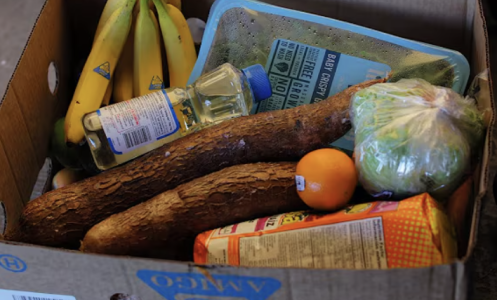What SNAP changes could mean for your grocery budget—23 governors speak out
By
Veronica E.
- Replies 0
If you or someone you know relies on SNAP benefits to help cover the cost of groceries, you’re not alone.
The program supports millions of Americans each month—including older adults—and any change to how it’s funded can make a big difference in everyday life.
Recently, a group of governors raised concerns about a new proposal that could shift costs away from the federal government and onto the states.
While no changes have taken effect yet, the warning signs are prompting questions about what this could mean for recipients.
Here’s a closer look at what’s being discussed, what’s at stake, and how it could impact older adults across the country.

SNAP, formerly known as food stamps, is a federally funded program that helps roughly 40 million Americans buy food.
While the benefits themselves are paid by the federal government, states share the responsibility for administrative costs.
A new legislative proposal—part of the “One Big Beautiful Bill Act”—would change that structure.
Under the current system, the USDA pays for all SNAP benefits while administrative costs are split 50/50 between states and the federal government.
The proposed change would require states to start sharing in the cost of benefits as well, with their financial obligations tied to how accurately they manage the program.
Supporters argue that this would encourage states to reduce payment errors. But critics say it’s an unrealistic burden that could threaten the stability of food aid across the country.
All 23 Democratic governors signed a letter to Congress urging lawmakers not to “gut” the program or shift financial responsibility to the states.
They warned that doing so would "effectively gut this critical food assistance that helps families with children, older adults, and working people afford the rising cost of groceries and put food on the table."
The governors wrote that Congress is putting states in an “impossible ultimatum”: either cover the shortfall or make cuts.
They called the expectation “unrealistic” and cautioned that failure to meet the new requirements could leave states with few options—such as reducing SNAP enrollment or withdrawing from the program entirely.
Their letter stated plainly: “Strained state budgets cannot backfill these cuts, especially as Congress simultaneously proposes to slash Medicaid, disaster relief, and other federally funded safety net programs.”
Here is the full list of governors who signed the letter to Congress:
The revised proposal would let states choose whether to use their SNAP payment error rates from 2025 or 2026 to calculate cost-sharing obligations starting in 2028.
Then, beginning in 2029, states would be assessed based on the average of their three most recent years of error rates.
If a state keeps its error rate under 6%, it won’t have to contribute financially. But if it exceeds that threshold, the state could be responsible for up to 15% of SNAP’s costs.
For states already balancing complex budgets—especially those facing proposed cuts to Medicaid and disaster recovery funds—this could present a major challenge.
According to critics, shifting the cost burden to the states could result in:
Colorado Governor Jared Polis warned: “Hundreds of thousands of Coloradans rely on SNAP to access food, and we urge Congress not to make these drastic cuts. These cuts would hurt children and families, communities and our economies, while stretching state budgets even further.”
Darcy Milburn, director of Social Security and health care policy at The Arc of the United States, also weighed in: “Shifting responsibility for funding SNAP onto states would upend state budgets. SNAP is an optional program for states, so state governments may decide to address this fiscal challenge by reducing SNAP benefits, restricting eligibility, or even opting out of SNAP entirely.”
Nearly 5 million older adults currently receive support through SNAP.
For those living on a fixed income, the program can help manage the cost of groceries and other essential expenses.
If states make changes to benefit amounts or eligibility requirements, it could affect how older Americans access food assistance—particularly individuals with limited income or specific health needs.
The House passed the SNAP portion of the bill in May, and the Senate Agriculture Committee is reviewing the proposal now.
Lawmakers are aiming to finalize the bill by Independence Day, making the next few weeks critical for the future of food assistance.
Read next: Your favorite restaurants could soon accept SNAP benefits—here’s what you need to know!

Are you worried about possible SNAP cuts? Have you already seen changes in your benefits? We’d love to hear your story, your tips, or your questions. Join the conversation in the comments—we’re all in this together.
The program supports millions of Americans each month—including older adults—and any change to how it’s funded can make a big difference in everyday life.
Recently, a group of governors raised concerns about a new proposal that could shift costs away from the federal government and onto the states.
While no changes have taken effect yet, the warning signs are prompting questions about what this could mean for recipients.
Here’s a closer look at what’s being discussed, what’s at stake, and how it could impact older adults across the country.

Millions of Americans—including seniors—rely on SNAP benefits to help cover the cost of groceries each month. Image Source: YouTube / PBS NewsHour.
A closer look at what’s changing
SNAP, formerly known as food stamps, is a federally funded program that helps roughly 40 million Americans buy food.
While the benefits themselves are paid by the federal government, states share the responsibility for administrative costs.
A new legislative proposal—part of the “One Big Beautiful Bill Act”—would change that structure.
Under the current system, the USDA pays for all SNAP benefits while administrative costs are split 50/50 between states and the federal government.
The proposed change would require states to start sharing in the cost of benefits as well, with their financial obligations tied to how accurately they manage the program.
Supporters argue that this would encourage states to reduce payment errors. But critics say it’s an unrealistic burden that could threaten the stability of food aid across the country.
Also read: SNAP benefits hit by massive scam surge—are your funds at risk?
Why governors are sounding the alarm
All 23 Democratic governors signed a letter to Congress urging lawmakers not to “gut” the program or shift financial responsibility to the states.
They warned that doing so would "effectively gut this critical food assistance that helps families with children, older adults, and working people afford the rising cost of groceries and put food on the table."
The governors wrote that Congress is putting states in an “impossible ultimatum”: either cover the shortfall or make cuts.
They called the expectation “unrealistic” and cautioned that failure to meet the new requirements could leave states with few options—such as reducing SNAP enrollment or withdrawing from the program entirely.
Their letter stated plainly: “Strained state budgets cannot backfill these cuts, especially as Congress simultaneously proposes to slash Medicaid, disaster relief, and other federally funded safety net programs.”
Also read: New data-sharing rules for SNAP: What recipients need to know
Which governors signed the letter?
Here is the full list of governors who signed the letter to Congress:
- Arizona Governor Katie Hobbs
- California Governor Gavin Newsom
- Connecticut Governor Ned Lamont
- Colorado Governor Jared Polis
- Delaware Governor Matt Meyer
- Hawaii Governor Josh Green
- Illinois Governor JB Pritzker
- Kansas Governor Laura Kelly
- Kentucky Governor Andy Beshear
- Maine Governor Janet Mills
- Maryland Governor Wes Moore
- Massachusetts Governor Maura Healey
- Michigan Governor Gretchen Whitmer
- Minnesota Governor Tim Walz
- New Jersey Governor Phil Murphy
- New Mexico Governor Michelle Lujan Grisham
- New York Governor Kathy Hochul
- North Carolina Governor Josh Stein
- Oregon Governor Tina Kotek
- Pennsylvania Governor Josh Shapiro
- Rhode Island Governor Dan McKee
- Washington Governor Bob Ferguson
- Wisconsin Governor Tony Evers
Also read: SNAP rules get an overhaul—Here’s what to know.
How the Senate plan would work
The revised proposal would let states choose whether to use their SNAP payment error rates from 2025 or 2026 to calculate cost-sharing obligations starting in 2028.
Then, beginning in 2029, states would be assessed based on the average of their three most recent years of error rates.
If a state keeps its error rate under 6%, it won’t have to contribute financially. But if it exceeds that threshold, the state could be responsible for up to 15% of SNAP’s costs.
For states already balancing complex budgets—especially those facing proposed cuts to Medicaid and disaster recovery funds—this could present a major challenge.
Also read: Will SNAP still cover your favorite beverages? What new state proposals say
What this could mean for everyday SNAP users
According to critics, shifting the cost burden to the states could result in:
- Reduced monthly benefits
- Stricter eligibility requirements
- States exiting the program altogether, leaving residents without food assistance
Colorado Governor Jared Polis warned: “Hundreds of thousands of Coloradans rely on SNAP to access food, and we urge Congress not to make these drastic cuts. These cuts would hurt children and families, communities and our economies, while stretching state budgets even further.”
Darcy Milburn, director of Social Security and health care policy at The Arc of the United States, also weighed in: “Shifting responsibility for funding SNAP onto states would upend state budgets. SNAP is an optional program for states, so state governments may decide to address this fiscal challenge by reducing SNAP benefits, restricting eligibility, or even opting out of SNAP entirely.”
Also read: New SNAP eligibility crackdown: Are you at risk of losing your benefits?
Why this matters for older adults
Nearly 5 million older adults currently receive support through SNAP.
For those living on a fixed income, the program can help manage the cost of groceries and other essential expenses.
If states make changes to benefit amounts or eligibility requirements, it could affect how older Americans access food assistance—particularly individuals with limited income or specific health needs.
What happens next?
The House passed the SNAP portion of the bill in May, and the Senate Agriculture Committee is reviewing the proposal now.
Lawmakers are aiming to finalize the bill by Independence Day, making the next few weeks critical for the future of food assistance.
Read next: Your favorite restaurants could soon accept SNAP benefits—here’s what you need to know!
Key Takeaways
- Twenty-three Democratic governors have urged Congress not to cut federal SNAP (food stamp) funding or shift financial responsibility to the states, warning it could leave millions without essential food aid.
- Proposed changes would base each state’s cost-sharing on their SNAP payment error rates, with a potential cap of 15%, starting in 2028.
- Critics—including state governors and policy experts—say states may not be able to absorb the extra costs, which could result in reduced benefits, stricter eligibility, or states dropping out of the program.
- SNAP supports about 40 million Americans, including nearly 5 million seniors, making it a key safety net program during a time of rising food prices and economic uncertainty.
Are you worried about possible SNAP cuts? Have you already seen changes in your benefits? We’d love to hear your story, your tips, or your questions. Join the conversation in the comments—we’re all in this together.






